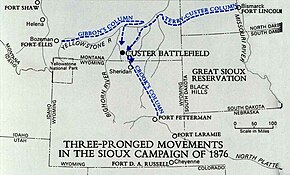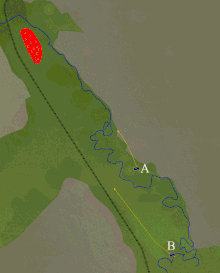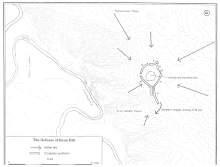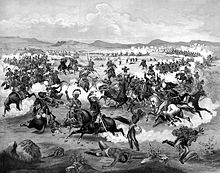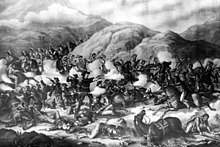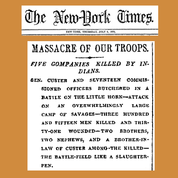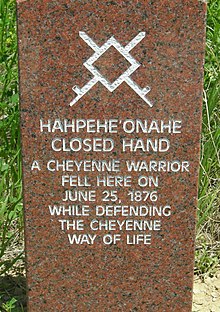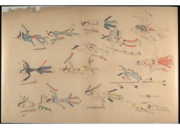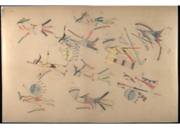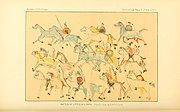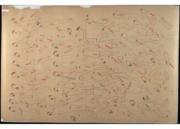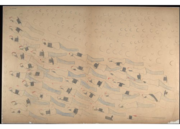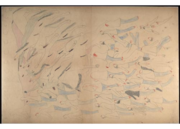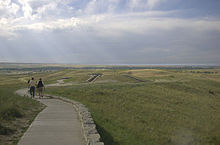THE LAST COMMAND CUSTER & 7TH CAVALRY AT the LITTLE BIG HORN - Battle of the Little Bighorn, June 25, 1876 by Kirk Stirnweis. Signed and numbered limited edition art print originally published in 1998 and long ago SOLD OUT. Limited to only 950 in the edition, no defects, never framed. Includes certificate of authenticity. Measures 25 1/2" x 18". Insured priority mail delivery in the Continental US. Will ship Worldwide and will combine shipping when practical. Will be shipped in a extra heavy duty tube that has to be purchased and not the cheap post office type that crushes easily.
The Battle of the Little Bighorn, known to the Lakota and other Plains Indians as the Battle of the Greasy Grass[10] and also commonly referred to as Custer's Last Stand, was an armed engagement between combined forces of the Lakota, Northern Cheyenne, and Arapaho tribes and the 7th Cavalry Regiment of the United States Army. The battle, which resulted in the defeat of US forces, was the most significant action of the Great Sioux War of 1876. It took place on June 25–26, 1876, along the Little Bighorn River in the Crow Indian Reservation in southeastern Montana Territory.[11]
The fight was an overwhelming victory for the Lakota, Northern Cheyenne, and Arapaho, who were led by several major war leaders, including Crazy Horse and Chief Gall, and had been inspired by the visions of Sitting Bull (Tȟatȟáŋka Íyotake). The US 7th Cavalry, a force of 700 men, suffered a major defeat while under the command of Lieutenant Colonel George Armstrong Custer (formerly a brevetted major general during the American Civil War). Five of the 7th Cavalry's twelve companies were annihilated and Custer was killed, as were two of his brothers, a nephew and a brother-in-law. The total US casualty count included 268 dead and 55 severely wounded (six died later from their wounds),[12] including four Crow Indian scouts and at least two Arikara Indian scouts.
Public response to the Great Sioux War varied in the immediate aftermath of the battle. Custer's widow (Libbie Custer) soon worked to burnish her husband's memory, and during the following decades Custer and his troops came to be considered iconic, even heroic, figures in American history. The battle, and Custer's actions in particular, have been studied extensively by historians.[13] Little Bighorn Battlefield National Monument honors those who fought on both sides.
Contents
Background[edit]
Battlefield and surrounding areas[edit]
In 1805, fur trader Francois Antoine Larocque reported joining a Crow camp in the Yellowstone area. On the way he noted that the Crow hunted buffalo on the "Small Horn River".[14] The US built Fort Raymond in 1807 for trade with the Crow. It was located near the confluence of the Yellowstone and the Bighorn River, about 40 miles (64 km) north of the future battlefield.[15] The area is first noted in the 1851 Treaty of Fort Laramie.[16]
In the latter half of the 19th century, tensions increased between the Native inhabitants of the Great Plains of the US and encroaching settlers. This resulted in a series of conflicts known as the Sioux Wars, which took place from 1854-90. While some of the indigenous people eventually agreed to relocate to ever-shrinking reservations, a number of them resisted, at times fiercely.[17]
On May 7, 1868, the valley of the Little Bighorn became a tract in the eastern part of the new Crow Indian Reservation in the center of the old Crow country.[18] There were numerous skirmishes between the Sioux and Crow tribes[19] so when the Sioux were in the valley in 1876 without the consent of the Crow tribe,[20] the Crow supported the US Army to expel them (e.g., Crows enlisted as Army scouts[21] and Crow warriors would fight in the nearby Battle of the Rosebud[22]).
The battlefield is known as "Greasy Grass" to the Lakota, Dakota, Cheyenne, and most other Plains Indians; however, in contemporary accounts by participants, it was referred to as the "Valley of Chieftains".[23]
1876 Sun Dance Gathering[edit]
Among the Plains Tribes, the long-standing ceremonial tradition known as the Sun Dance was the most important religious event of the year. It is a time for prayer and personal sacrifice on behalf of the community, as well as making personal vows. Towards the end of spring in 1876, the Lakota and the Cheyenne held a Sun Dance that was also attended by a number of "Agency Indians" who had slipped away from their reservations.[24] During a Sun Dance around June 5, 1876, on Rosebud Creek in Montana, Sitting Bull, the spiritual leader of the Hunkpapa Lakota, reportedly had a vision of "soldiers falling into his camp like grasshoppers from the sky."[25] At the same time US military officials were conducting a summer campaign to force the Lakota and the Cheyenne back to their reservations, using infantry and cavalry in a so-called "three-pronged approach".
1876 U.S. military campaign[edit]
Col. John Gibbon's column of six companies (A, B, E, H, I, and K) of the 7th Infantry and four companies (F, G, H, and L) of the 2nd Cavalry marched east from Fort Ellis in western Montana on March 30 to patrol the Yellowstone River. Brig. Gen. George Crook's column of ten companies (A, B, C, D, E, F, G, I, L, and M) of the 3rd Cavalry, five companies (A, B, D, E, and I) of the 2nd Cavalry, two companies (D and F) of the 4th Infantry, and three companies (C, G, and H) of the 9th Infantry moved north from Fort Fetterman in the Wyoming Territory on May 29, marching toward the Powder River area. Brig. Gen. Alfred Terry's column, including twelve companies (A, B, C, D, E, F, G, H, I, K, L, and M) of the 7th Cavalry under Lt. Col. George Armstrong Custer's immediate command,[26] Companies C and G of the 17th U.S. Infantry, and the Gatling gun detachment of the 20th Infantry departed westward from Fort Abraham Lincoln in the Dakota Territory on May 17. They were accompanied by teamsters and packers with 150 wagons and a large contingent of pack mules that reinforced Custer. Companies C, D, and I of the 6th U.S. Infantry moved along the Yellowstone River from Fort Buford on the Missouri River to set up a supply depot and joined Terry on May 29 at the mouth of the Powder River. They were later joined there by the steamboat Far West, which was loaded with 200 tons of supplies from Fort Lincoln.[27]
7th Cavalry organization[edit]
The 7th Cavalry had been created just after the American Civil War. Many men were veterans of the war, including most of the leading officers. A significant portion of the regiment had previously served 4-1/2 years at Fort Riley, Kansas, during which time it fought one major engagement and numerous skirmishes, experiencing casualties of 36 killed and 27 wounded. Six other troopers had died of drowning and 51 in cholera epidemics. In November 1868, while stationed in Kansas, the 7th Cavalry under Custer had successfully routed Black Kettle's Southern Cheyenne camp on the Washita River in the Battle of Washita River, an attack which was at the time labeled a "massacre of innocent Indians" by the Indian Bureau.[28]
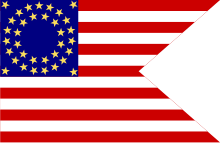
By the time of the Little Bighorn, half of the 7th Cavalry's companies had just returned from 18 months of constabulary duty in the Deep South, having been recalled to Fort Abraham Lincoln, Dakota Territory to reassemble the regiment for the campaign. About 20% of the troopers had been enlisted in the prior seven months (139 of an enlisted roll of 718), were only marginally trained and had no combat or frontier experience. A sizable number of these recruits were immigrants from Ireland, England and Germany, just as many of the veteran troopers had been before their enlistments. Archaeological evidence suggests that many of these troopers were malnourished and in poor physical condition, despite being the best-equipped and supplied regiment in the Army.[29][30]
Of the 45 officers and 718 troopers then assigned to the 7th Cavalry (including a second lieutenant detached from the 20th Infantry and serving in Company L), 14 officers (including the regimental commander) and 152 troopers did not accompany the 7th during the campaign. The regimental commander, Colonel Samuel D. Sturgis, was on detached duty as the Superintendent of Mounted Recruiting Service and in command of the Cavalry Depot in St. Louis, Missouri,[31] which left Lieutenant Colonel Custer in command of the regiment. The ratio of troops detached for other duty (approximately 22%) was not unusual for an expedition of this size,[32] and part of the officer shortage was chronic, due to the Army's rigid seniority system: three of the regiment's 12 captains were permanently detached, and two had never served a day with the 7th since their appointment in July 1866.[note 1] Three second lieutenant vacancies (in E, H, and L Companies) were also unfilled.
Battle of the Rosebud[edit]
The Army's coordination and planning began to go awry on June 17, 1876, when Crook's column retreated after the Battle of the Rosebud, just 30 miles (48 km) to the southeast of the eventual Little Bighorn battlefield. Surprised and according to some accounts astonished by the unusually large numbers of Native Americans, Crook held the field at the end of the battle but felt compelled by his losses to pull back, regroup, and wait for reinforcements. Unaware of Crook's battle, Gibbon and Terry proceeded, joining forces in early June near the mouth of Rosebud Creek. They reviewed Terry's plan calling for Custer's regiment to proceed south along the Rosebud while Terry and Gibbon's united forces would move in a westerly direction toward the Bighorn and Little Bighorn rivers. As this was the likely location of native encampments, all army elements had been instructed to converge there around June 26 or 27 in an attempt to engulf the Native Americans. On June 22, Terry ordered the 7th Cavalry, composed of 31 officers and 566 enlisted men under Custer, to begin a reconnaissance in force and pursuit along the Rosebud, with the prerogative to "depart" from orders if Custer saw "sufficient reason". Custer had been offered the use of Gatling guns but declined, believing they would slow his command.[26]
Little Bighorn[edit]
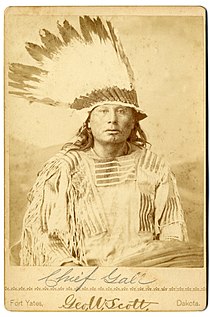 Gall Gall | |
While the Terry-Gibbon column was marching toward the mouth of the Little Bighorn, on the evening of June 24, Custer's Indian scouts arrived at an overlook known as the Crow's Nest, 14 miles (23 km) east of the Little Bighorn River. At sunrise on June 25, Custer's scouts reported they could see a massive pony herd and signs of the Native American village[note 2] roughly 15 miles (24 km) in the distance. After a night's march, the tired officer who was sent with the scouts could see neither, and when Custer joined them, he was also unable to make the sighting. Custer's scouts also spotted the regimental cooking fires that could be seen from 10 mi (16 km) away, disclosing the regiment's position.[citation needed]
Custer contemplated a surprise attack against the encampment the following morning of June 26, but he then received a report informing him several hostiles had discovered the trail left by his troops.[35] Assuming his presence had been exposed, Custer decided to attack the village without further delay. On the morning of June 25, Custer divided his 12 companies into three battalions in anticipation of the forthcoming engagement. Three companies were placed under the command of Major Marcus Reno (A, G, and M) and three were placed under the command of Captain Frederick Benteen (H, D, and K). Five companies (C, E, F, I, and L) remained under Custer's immediate command. The 12th, Company B under Captain Thomas McDougall, had been assigned to escort the slower pack train carrying provisions and additional ammunition.[26]
Unknown to Custer, the group of Native Americans seen on his trail was actually leaving the encampment and did not alert the rest of the village. Custer's scouts warned him about the size of the village, with Mitch Bouyer reportedly saying, "General, I have been with these Indians for 30 years, and this is the largest village I have ever heard of."[note 3][37] Custer's overriding concern was that the Native American group would break up and scatter. The command began its approach to the village at noon and prepared to attack in full daylight.[38]
Prelude[edit]
Military assumptions prior to the battle[edit]
Number of Indian warriors[edit]
As the Army moved into the field on its expedition, it was operating with incorrect assumptions as to the number of Indians it would encounter. These assumptions were based on inaccurate information provided by the Indian Agents that no more than 800 hostiles were in the area. The Indian Agents based this estimate on the number of Lakota that Sitting Bull and other leaders had reportedly led off the reservation in protest of U.S. government policies. It was in fact a correct estimate until several weeks before the battle, when the "reservation Indians" joined Sitting Bull's ranks for the summer buffalo hunt. The agents did not take into account the many thousands of these "reservation Indians" who had unofficially left the reservation to join their "uncooperative non-reservation cousins led by Sitting Bull". Thus, Custer unknowingly faced thousands of Indians, including the 800 non-reservation "hostiles". All Army plans were based on the incorrect numbers. Although Custer was criticized after the battle for not having accepted reinforcements and for dividing his forces, it appears that he had accepted the same official government estimates of hostiles in the area which Terry and Gibbon had also accepted. Historian James Donovan notes, however, that when Custer later asked interpreter Fred Gerard for his opinion on the size of the opposition, he estimated the force at between 1,500 to 2,500 warriors.[39]
Additionally, Custer was more concerned with preventing the escape of the Lakota and Cheyenne than with fighting them. From his own observation, as reported by his bugler John Martin (Martini),[40] Custer assumed the warriors had been sleeping in on the morning of the battle, to which virtually every native account attested later, giving Custer a false estimate of what he was up against. When he and his scouts first looked down on the village from the Crow's Nest across the Little Bighorn River, they could only see the herd of ponies. Later ,looking from a hill 2.5 miles (4.0 km) away after parting with Reno's command, Custer could observe only women preparing for the day, and young boys taking thousands of horses out to graze south of the village. Custer's Crow scouts told him it was the largest native village they had ever seen. When the scouts began changing back into their native dress right before the battle, Custer released them from his command. While the village was enormous in size, Custer still thought there were far fewer warriors to defend the village.
Finally, Custer may have assumed when he encountered the Native Americans, his subordinate Benteen, and with the pack train, would provide support. Rifle volleys were a standard way of telling supporting units to come to another unit's aid. In a subsequent official 1879 Army investigation requested by Major Reno, the Reno Board of Inquiry (RCOI), Benteen and Reno's men testified that they heard distinct rifle volleys as late as 4:30 pm during the battle.[41]
Custer had initially wanted to take a day to scout the village before attacking; however, when men went back looking for supplies accidentally dropped by the pack train, they discovered that their track had already been discovered by Indians. Reports from his scouts also revealed fresh pony tracks from ridges overlooking his formation. It became apparent that the warriors in the village were either aware of or would soon be aware of his approach.[42] Fearing that the village would break up into small bands that he would have to chase, Custer began to prepare for an immediate attack.[43]
Role of Indian noncombatants in Custer's strategy[edit]
Custer's field strategy was designed to engage noncombatants at the encampments on the Little Bighorn so as to capture women, children, and the elderly or disabled[44]:297 to serve as hostages to convince the warriors to surrender and comply with federal orders to relocate. Custer's battalions were poised to "ride into the camp and secure noncombatant hostages"[45] and "forc[e] the warriors to surrender".[46] Author Evan S. Connell observed that if Custer could occupy the village before widespread resistance developed, the Sioux and Cheyenne warriors "would be obliged to surrender, because if they started to fight, they would be endangering their families."[44]:312[47]
In Custer's book My Life on the Plains, published two years before the Battle of the Little Bighorn, he asserted:
Indians contemplating a battle, either offensive or defensive, are always anxious to have their women and children removed from all danger ... For this reason I decided to locate our [military] camp as close as convenient to [Chief Black Kettle's Cheyenne] village, knowing that the close proximity of their women and children, and their necessary exposure in case of conflict, would operate as a powerful argument in favor of peace, when the question of peace or war came to be discussed.[48]
On Custer's decision to advance up the bluffs and descend on the village from the east, Lt. Edward Godfrey of Company K surmised:
[Custer] expected to find the squaws and children fleeing to the bluffs on the north, for in no other way do I account for his wide detour. He must have counted upon Reno's success, and fully expected the "scatteration" of the non-combatants with the pony herds. The probable attack upon the families and capture of the herds were in that event counted upon to strike consternation in the hearts of the warriors, and were elements for success upon which General Custer fully counted.[49]:379
The Sioux and Cheyenne fighters were acutely aware of the danger posed by the military engagement of noncombatants and that "even a semblance of an attack on the women and children" would draw the warriors back to the village, according to historian John S. Gray.[50] Such was their concern that an apparent reconnaissance by Capt. Yates' E and F Companies at the mouth of Medicine Tail Coulee (Minneconjou Ford) caused hundreds of warriors to disengage from the Reno valley fight and return to deal with the threat to the village.[50]
Some authors and historians, based on archaeological evidence and reviews of native testimony, speculate that Custer attempted to cross the river at a point further north they refer to as Ford D. According to Richard A. Fox, James Donovan, and others, Custer proceeded with a wing of his battalion (Yates' Troops E and F) north and opposite the Cheyenne circle at that crossing,[44]:176–77 which provided "access to the [women and children] fugitives."[44]:306 Yates's force "posed an immediate threat to fugitive Indian families..." gathering at the north end of the huge encampment;[44]:299 he then persisted in his efforts to "seize women and children" even as hundreds of warriors were massing around Keogh's wing on the bluffs.[51] Yates' wing, descending to the Little Bighorn River at Ford D, encountered "light resistance",[44]:297 undetected by the Indian forces ascending the bluffs east of the village.[44]:298 Custer was almost within "striking distance of the refugees" before abandoning the ford and returning to Custer Ridge.[52]
Lone Teepee[edit]
The Lone Teepee (or Tipi) was a landmark along the 7th Cavalry's march. It was where the Indian encampment had been a week earlier, during the Battle of the Rosebud on June 17, 1876. The Indians had left a single teepee standing (some reports mention a second that had been partially dismantled), and in it was the body of a Sans Arc warrior, Old She-Bear, who had been wounded in the battle. He had died a couple of days after the Rosebud battle, and it was the custom of the Indians to move camp when a warrior died and leave the body with its possessions. The Lone Teepee was an important location during the Battle of the Little Bighorn for several reasons, including:[53][54][55]
- It is where Custer gave Reno his final orders to attack the village ahead. It is also where some Indians who had been following the command were seen and Custer assumed he had been discovered.
- Many of the survivors' accounts use the Lone Teepee as a point of reference for event times or distances.
- Knowing this location helps establish the pattern of the Indians' movements to the encampment on the river where the soldiers found them.
Battle[edit]
Reno's attack[edit]
The first group to attack was Major Reno's second detachment (Companies A, G and M) after receiving orders from Custer written out by Lt. William W. Cooke, as Custer's Crow scouts reported Sioux tribe members were alerting the village. Ordered to charge, Reno began that phase of the battle. The orders, made without accurate knowledge of the village's size, location, or the warriors' propensity to stand and fight, had been to pursue the Native Americans and "bring them to battle." Reno's force crossed the Little Bighorn at the mouth of what is today Reno Creek around 3:00 pm on June 25. They immediately realized that the Lakota and Northern Cheyenne were present "in force and not running away."
Reno advanced rapidly across the open field towards the northwest, his movements masked by the thick bramble of trees that ran along the southern banks of the Little Bighorn River. The same trees on his front right shielded his movements across the wide field over which his men rapidly rode, first with two approximately forty-man companies abreast and eventually with all three charging abreast. The trees also obscured Reno's view of the Native American village until his force had passed that bend on his right front and was suddenly within arrow-shot of the village. The tepees in that area were occupied by the Hunkpapa Sioux. Neither Custer nor Reno had much idea of the length, depth and size of the encampment they were attacking, as the village was hidden by the trees.[citation needed] When Reno came into the open in front of the south end of the village, he sent his Arikara/Ree and Crow Indian scouts forward on his exposed left flank.[56] Realizing the full extent of the village's width, Reno quickly suspected what he would later call "a trap" and stopped a few hundred yards short of the encampment.
He ordered his troopers to dismount and deploy in a skirmish line, according to standard army doctrine. In this formation, every fourth trooper held the horses for the troopers in firing position, with five to ten yards separating each trooper, officers to their rear and troopers with horses behind the officers. This formation reduced Reno's firepower by 25 percent. As Reno's men fired into the village and killed, by some accounts, several wives and children of the Sioux leader, Chief Gall (in Lakota, Phizí), the mounted warriors began streaming out to meet the attack. With Reno's men anchored on their right by the protection of the tree line and bend in the river, the Indians rode against the center and exposed left end of Reno's line. After about 20 minutes of long-distance firing, Reno had taken only one casualty, but the odds against him had risen (Reno estimated five to one), and Custer had not reinforced him. Trooper Billy Jackson reported that by then, the Indians had begun massing in the open area shielded by a small hill to the left of Reno's line and to the right of the Indian village.[57] From this position the Indians mounted an attack of more than 500 warriors against the left and rear of Reno's line,[58] turning Reno's exposed left flank. This forced a hasty withdrawal into the timber along the bend in the river.[59] Here the Indians pinned Reno and his men down and tried to set fire to the brush to try to drive the soldiers out of their position.
After giving orders to mount, dismount and mount again, Reno told his men withing earshot, "All those who wish to make their escape follow me," and led a disorderly rout across the river toward the bluffs on the other side. The retreat was immediately disrupted by Cheyenne attacks at close quarters. Later, Reno reported that three officers and 29 troopers had been killed during the retreat and subsequent fording of the river. Another officer and 13–18 men were missing. Most of these missing men were left behind in the timber, although many eventually rejoined the detachment. Reno's hasty retreat may have been precipitated by the death of Reno's Arikara scout Bloody Knife, who had been shot in the head as he sat on his horse next to Reno, his blood and brains splattering the side of Reno's face.
Reno and Benteen on Reno Hill[edit]
This section needs additional citations for verification. (December 2013) (Learn how and when to remove this template message) |
Atop the bluffs, known today as Reno Hill, Reno's depleted and shaken troops were joined by Captain Benteen's column (Companies D, H and K), arriving from the south. This force had been returning from a lateral scouting mission when it had been summoned by Custer's messenger, Italian bugler John Martin (Giovanni Martini) with the handwritten message "Benteen. Come on, Big Village, Be quick, Bring packs. P.S. Bring Packs.".[41] Benteen's coincidental arrival on the bluffs was just in time to save Reno's men from possible annihilation. Their detachments were later reinforced by McDougall's Company B and the pack train. The 14 officers and 340 troopers on the bluffs organized an all-around defense and dug rifle pits using whatever implements they had among them, including knives. This practice had become standard during the last year of the American Civil War, with both Union and Confederate troops utilizing knives, eating utensils, mess plates and pans to dig effective battlefield fortifications.[60]
Despite hearing heavy gunfire from the north, including distinct volleys at 4:20 pm, Benteen concentrated on reinforcing Reno's badly wounded and hard-pressed detachment rather than continuing on toward Custer's position. Benteen's apparent reluctance to reach Custer prompted later criticism that he had failed to follow orders. Around 5:00 pm, Capt. Thomas Weir and Company D moved out to make contact with Custer.[41] They advanced a mile, to what is today Weir Ridge or Weir Point, and could see in the distance native warriors on horseback shooting at objects on the ground. By this time, roughly 5:25 pm, Custer's battle may have concluded. The conventional historical understanding is that what Weir witnessed was most likely warriors killing the wounded soldiers and shooting at dead bodies on the "Last Stand Hill" at the northern end of the Custer battlefield. Some contemporary historians have suggested instead that what Weir witnessed was a fight on what is now called Calhoun Hill, some minutes earlier. The destruction of Keogh's battalion may have begun with the collapse of L, I and C Company (half of it) following the combined assaults led by Crazy Horse, White Bull, Hump, Chief Gall and others.[61]:240 Other native accounts contradict this understanding, however, and the time element remains a subject of debate. The other entrenched companies eventually left Reno HIll and followed Weir by assigned battalions, first Benteen, then Reno, and finally the pack train. Growing attacks around Weir Ridge by natives coming from the apparently concluded Custer engagement forced all seven companies to return to the bluff before the pack train, with the ammunition, had moved even a quarter mile. The companies remained pinned down on the bluff for another day, but the natives were unable to breach the tightly held position.
Benteen was hit in the heel of his boot by an Indian bullet. At one point, he personally led a counterattack to push back Indians who had continued to crawl through the grass closer to the soldier's positions.[62]
Custer's fight[edit]

The precise details of Custer's fight are largely conjectural since none of the men who went forward with Custer's battalion (the five companies under his immediate command) survived the battle. Later accounts from surviving Indians are useful, but sometimes conflicting and unclear.
While the gunfire heard on the bluffs by Reno and Benteen's men was probably from Custer's fight, the soldiers on Reno Hill were unaware of what had happened to Custer until General Terry's arrival on June 27. They were reportedly stunned by the news. When the army examined the Custer battle site, soldiers could not determine fully what had transpired. Custer's force of roughly 210 men had been engaged by the Lakota and Northern Cheyenne about 3.5 miles (5.6 km) to the north of Reno and Benteen's defensive position. Evidence of organized resistance included an apparent skirmish line on Calhoun Hill and apparent breastworks made of dead horses on Custer Hill.[61] By the time troops came to recover the bodies, the Lakota and Cheyenne had already removed most of their dead from the field. The troops found most of Custer's dead stripped of their clothing, ritually mutilated, and in a state of decomposition, making identification of many impossible.[65] The soldiers identified the 7th Cavalry's dead as best as possible and hastily buried them where they fell.
Custer was found with shots to the left chest and left temple. Either wound would have been fatal, though he appeared to have bled from only the chest wound, meaning his head wound may have been delivered postmortem. Some Lakota oral histories assert that Custer committed suicide to avoid capture and subsequent torture, though this is usually discounted since the wounds were inconsistent with his known right-handedness. (Other native accounts note several soldiers committing suicide near the end of the battle.)[66] Custer's body was found near the top of Custer Hill, which also came to be known as "Last Stand Hill". There the United States erected a tall memorial obelisk inscribed with the names of the 7th Cavalry's casualties.[65]
Several days after the battle, Curley, Custer's Crow scout who had left Custer near Medicine Tail Coulee (a drainage which led to the river), recounted the battle, reporting that Custer had attacked the village after attempting to cross the river. He was driven back, retreating toward the hill where his body was found.[67] As the scenario seemed compatible with Custer's aggressive style of warfare and with evidence found on the ground, it became the basis of many popular accounts of the battle.
According to Pretty Shield, the wife of Goes-Ahead (another Crow scout for the 7th Cavalry), Custer was killed while crossing the river: "... and he died there, died in the water of the Little Bighorn, with Two-bodies, and the blue soldier carrying his flag".[68]:136 In this account, Custer was allegedly killed by a Lakota called Big-nose.[68]:141 However, in Chief Gall's version of events, as recounted to Lt. Edward Settle Godfrey, Custer did not attempt to ford the river and the nearest that he came to the river or village was his final position on the ridge.[49]:380 Chief Gall's statements were corroborated by other Indians, notably the wife of Spotted Horn Bull.[49]:379 Given that no bodies of men or horses were found anywhere near the ford, Godfrey himself concluded "that Custer did not go to the ford with any body of men".[49]:380
Cheyenne oral tradition credits Buffalo Calf Road Woman with striking the blow that knocked Custer off his horse before he died.[69]
Custer at Minneconjou Ford[edit]
- Reported words of Lieutenant Colonel Custer at the battle's outset.[70]
Having isolated Reno's force and driven them away from the encampment, the bulk of the native warriors were free to pursue Custer. The route taken by Custer to his "Last Stand" remains a subject of debate. One possibility is that after ordering Reno to charge, Custer continued down Reno Creek to within about a half-mile (800 m) of the Little Bighorn, but then turned north and climbed up the bluffs, reaching the same spot to which Reno would soon retreat. From this point on the other side of the river, he could see Reno charging the village. Riding north along the bluffs, Custer could have descended into Medicine Tail Coulee. Some historians believe that part of Custer's force descended the coulee, going west to the river and attempting unsuccessfully to cross into the village. According to some accounts, a small contingent of Indian sharpshooters effectively opposed this crossing.
White Cow Bull claimed to have shot a leader wearing a buckskin jacket off his horse in the river. While no other Indian account supports this claim, if White Bull did shoot a buckskin-clad leader off his horse, some historians have argued that Custer may have been seriously wounded by him. Some Indian accounts claim that besides wounding one of the leaders of this advance, a soldier carrying a company guidon was also hit.[71] Troopers had to dismount to help the wounded men back onto their horses.[61]:117–19 The fact that either of the non-mutilation wounds to Custer's body (a bullet wound below the heart and a shot to the left temple) would have been instantly fatal casts doubt on his being wounded and remounted.[72]
Reports of an attempted fording of the river at Medicine Tail Coulee might explain Custer's purpose for Reno's attack, that is, a coordinated "hammer-and-anvil" maneuver, with Reno's holding the Indians at bay at the southern end of the camp, while Custer drove them against Reno's line from the north. Other historians have noted that if Custer did attempt to cross the river near Medicine Tail Coulee, he may have believed it was the north end of the Indian camp, only to discover that it was only the middle. Some Indian accounts, however, place the Northern Cheyenne encampment and the north end of the overall village to the left (and south) of the opposite side of the crossing.[61]:10–20 The precise location of the north end of the village remains in dispute, however.

Edward Curtis, the famed ethnologist and photographer of the Native American Indians, made a detailed personal study of the battle, interviewing many of those who had fought or taken part in it. First he went over the ground covered by the troops with the three Crow scouts White Man Runs Him, Goes Ahead, and Hairy Moccasin, and then again with Two Moons and a party of Cheyenne warriors. He also visited the Lakota country and interviewed Red Hawk, "whose recollection of the fight seemed to be particularly clear".[73]:44 Then, he went over the battlefield once more with the three Crow scouts, but also accompanied by General Charles Woodruff "as I particularly desired that the testimony of these men might be considered by an experienced army officer". Finally, Curtis visited the country of the Arikara and interviewed the scouts of that tribe who had been with Custer's command.[73]:44 Based on all the information he gathered, Curtis concluded that Custer had indeed ridden down the Medicine Tail Coulee and then towards the river where he probably planned to ford it. However, "the Indians had now discovered him and were gathered closely on the opposite side".[73]:48 They were soon joined by a large force of Sioux who (no longer engaging Reno) rushed down the valley. This was the beginning of their attack on Custer who was forced to turn and head for the hill where he would make his famous "last stand". Thus, wrote Curtis, "Custer made no attack, the whole movement being a retreat".[73]:49
Other views of Custer's actions at Minneconjou Ford[edit]
This section needs additional citations for verification. (December 2013) (Learn how and when to remove this template message) |
Other historians claim that Custer never approached the river, but rather continued north across the coulee and up the other side, where he gradually came under attack. According to this theory, by the time Custer realized he was badly outnumbered, it was too late to break back to the south where Reno and Benteen could have provided assistance. Two men from the 7th Cavalry, the young Crow scout Ashishishe (known in English as Curley) and the trooper Peter Thompson, claimed to have seen Custer engage the Indians. The accuracy of their recollections remains controversial; accounts by battle participants and assessments by historians almost universally discredit Thompson's claim.
Archaeological evidence and reassessment of Indian testimony has led to a new interpretation of the battle. In the 1920s, battlefield investigators discovered hundreds of .45–55 shell cases along the ridge line known today as Nye-Cartwright Ridge, between South Medicine Tail Coulee and the next drainage at North Medicine Tail (also known as Deep Coulee). Some historians believe Custer divided his detachment into two (and possibly three) battalions, retaining personal command of one while presumably delegating Captain George W. Yates to command the second.
Evidence from the 1920s supports the theory that at least one of the companies made a feint attack southeast from Nye-Cartwright Ridge straight down the center of the "V" formed by the intersection at the crossing of Medicine Tail Coulee on the right and Calhoun Coulee on the left. The intent may have been to relieve pressure on Reno's detachment (according to the Crow scout Curley, possibly viewed by both Mitch Bouyer and Custer) by withdrawing the skirmish line into the timber on the edge of the Little Bighorn River. Had the U.S. troops come straight down Medicine Tail Coulee, their approach to the Minneconjou Crossing and the northern area of the village would have been masked by the high ridges running on the northwest side of the Little Bighorn River.
That they might have come southeast, from the center of Nye-Cartwright Ridge, seems to be supported by Northern Cheyenne accounts of seeing the approach of the distinctly white-colored horses of Company E, known as the Grey Horse Company. Its approach was seen by Indians at that end of the village. Behind them, a second company, further up on the heights, would have provided long-range cover fire. Warriors could have been drawn to the feint attack, forcing the battalion back towards the heights, up the north fork drainage, away from the troops providing cover fire above. The covering company would have moved towards a reunion, delivering heavy volley fire and leaving the trail of expended cartridges discovered 50 years later.
Last stand[edit]

In the end, the hilltop to which Custer had moved was probably too small to accommodate all of the survivors and wounded. Fire from the southeast made it impossible for Custer's men to secure a defensive position all around Last Stand Hill where the soldiers put up their most dogged defense. According to Lakota accounts, far more of their casualties occurred in the attack on Last Stand Hill than anywhere else. The extent of the soldiers' resistance indicated they had few doubts about their prospects for survival. According to Cheyenne and Sioux testimony, the command structure rapidly broke down, although smaller "last stands" were apparently made by several groups. Custer's remaining companies (E, F, and half of C) were soon killed.
By almost all accounts, the Lakota annihilated Custer's force within an hour of engagement.[74][75][76] David Humphreys Miller, who between 1935 and 1955 interviewed the last Lakota survivors of the battle, wrote that the Custer fight lasted less than one-half hour.[77] Other native accounts said the fighting lasted only "as long as it takes a hungry man to eat a meal." The Lakota asserted that Crazy Horse personally led one of the large groups of warriors who overwhelmed the cavalrymen in a surprise charge from the northeast, causing a breakdown in the command structure and panic among the troops. Many of these men threw down their weapons while Cheyenne and Sioux warriors rode them down, "counting coup" with lances, coup sticks, and quirts. Some Native accounts recalled this segment of the fight as a "buffalo run."[78]
Captain Frederick Benteen, battalion leader of Companies D, H and K, recalled his observations on the Custer battlefield on June 27, 1876
I went over the battlefield carefully with a view to determine how the battle was fought. I arrived at the conclusion I [hold] now – that it was a rout, a panic, until the last man was killed ...
There was no line formed on the battlefield. You can take a handful of corn and scatter [the kernels] over the floor, and make just such lines. There were none ... The only approach to a line was where 5 or 6 [dead] horses found at equal distances, like skirmishers [part of Lt. Calhoun's Company L]. That was the only approach to a line on the field. There were more than 20 [troopers] killed [in one group]; there were [more often] four or five at one place, all within a space of 20 to 30 yards [of each other] ... I counted 70 dead [cavalry] horses and 2 Indian ponies.
I think, in all probability, that the men turned their horses loose without any orders to do so. Many orders might have been given, but few obeyed. I think that they were panic stricken; it was a rout, as I said before.[79]
A Brulé Sioux warrior stated: "In fact, Hollow Horn Bear believed that the troops were in good order at the start of the fight, and kept their organization even while moving from point to point."[80] Red Horse, an Oglala Sioux warrior, commented: "Here [Last Stand Hill] the soldiers made a desperate fight."[81] One Hunkpapa Sioux warrior, Moving Robe, noted that "It was a hotly contested battle",[82] while another, Iron Hawk, stated: "The Indians pressed and crowded right in around Custer Hill. But the soldiers weren't ready to die. We stood there a long time."[83] In a letter from February 21, 1910, Private William Taylor, Company M, 7th Cavalry, wrote: "Reno proved incompetent and Benteen showed his indifference – I will not use the uglier words that have often been in my mind. Both failed Custer and he had to fight it out alone."[84]
Custer's final resistance[edit]
Recent archaeological work[85] at the battlefield indicates that officers on Custer Hill restored some tactical control. E Company rushed off Custer Hill toward the Little Bighorn River but failed to reach it, which resulted in the total destruction of that company. This left about 50-60 men, mostly from F Company and the staff, on Last Stand Hill. The remainder of the battle took on the nature of a running fight. Modern archaeology and historical Indian accounts indicate that Custer's force may have been divided into three groups, with the Indians attempting to prevent them from effectively reuniting. Indian accounts describe warriors (including women) running up from the village to wave blankets in order to scare off the soldiers' horses. One 7th Cavalry trooper claimed finding a number of stone mallets consisting of a round cobble weighing 8–10 pounds (about 4 kg) with a rawhide handle, which he believed had been used by the Indian women to finish off the wounded.[86] Fighting dismounted, the soldiers' skirmish lines were overwhelmed. Army doctrine would have called for one man in four to be a horseholder behind the skirmish lines and, in extreme cases, one man in eight. Later, the troops would have bunched together in defensive positions and are alleged to have shot their remaining horses as cover. As individual troopers were wounded or killed, initial defensive positions would have been abandoned as untenable.[87]
Under threat of attack, the first U.S. soldiers on the battlefield three days later hurriedly buried the troopers in shallow graves, more or less where they had fallen. A couple of years after the battle, markers were placed where men were believed to have fallen, so the placement of troops has been roughly construed. The troops evidently died in several groups, including on Custer Hill, around Captain Myles Keogh, and strung out towards the Little Bighorn River.[87]
Last break-out attempt[edit]

Modern documentaries suggest that there may not have been a "Last Stand" as traditionally portrayed in popular culture. Instead, archaeologists suggest that, in the end, Custer's troops were not surrounded but rather overwhelmed by a single charge. This scenario corresponds to several Indian accounts stating Crazy Horse's charge swarmed the resistance, with the surviving soldiers fleeing in panic.[61][note 4] Many of these troopers may have ended up in a deep ravine 300–400 yards away from what is known today as Custer Hill. At least 28 bodies (the most common number associated with burial witness testimony), including that of scout Mitch Bouyer, were discovered in or near that gulch, their deaths possibly the battle's final actions. Although the marker for Mitch Bouyer has been accounted for as being accurate through archaeological and forensic testing,[88] it is some 65 yards away from Deep Ravine. Scott in his book "They Died With Custer: Soldiers Bones from the Battle of the Little Big Horn" puts forth the theory that the "Deep Gulch" or "Deep Ravine" might included not only the steep sided portion of the coulee, but the entire drainage including its tributaries. If one uses this interpretation then Bouyer's and other bodies are located where eye witnesses said they were seen.
Other archaeological explorations done in Deep Ravine[89] have found no human remains associated with the battle. In Scott's later book "They Died with Custer..." he reports that skeletal remains were recovered in the years after the battle from the mouth of the Deep Ravine and that bones have been repatriated to the Little Big Horn National Monument from various sources that were reported to have been collected from the Ravine in years after the battle. It is likely that remains have in the 108 years between Scott's excavation efforts in the ravine and the battle, the geological processes have washed the remains away. As an example of this the reader can refer to the skeletal remains recovered eroding from the bank of the Little Big Horn near the town of Garryowen. The remains were from a trooper killed in the Reno Retreat. Only part of the skeleton were recovered, the rest had been washed away by the river.[90]
According to Indian accounts, about 40 men made a desperate stand around Custer on Custer Hill, delivering volley fire.[61] The great majority of the Indian casualties were probably suffered during this closing segment of the battle, as the soldiers and Indians on Calhoun Ridge were more widely separated and traded fire at greater distances for most of their portion of the battle than did the soldiers and Indians on Custer Hill.[61]:282
Aftermath[edit]

After the Custer force was soundly defeated, the Lakota and Northern Cheyenne regrouped to attack Reno and Benteen. The fight continued until dark (approximately 9:00 pm) and for much of the next day, with the outcome in doubt. Reno credited Benteen's luck with repulsing a severe attack on the portion of the perimeter held by Companies H and M.[note 5] On June 27, the column under General Terry approached from the north, and the natives drew off in the opposite direction. The Crow scout White Man Runs Him was the first to tell General Terry's officers that Custer's force had "been wiped out." Reno and Benteen's wounded troops were given what treatment was available at that time; five later died of their wounds. One of the regiment's three surgeons had been with Custer's column, while another, Dr. DeWolf, had been killed during Reno's retreat.[96] The only remaining doctor was Assistant Surgeon Henry R. Porter.[97]
News of the defeat arrived in the East as the U.S. was observing its centennial.[98][99] The Army began to investigate, although its effectiveness was hampered by a concern for survivors, and the reputation of the officers. Custer's wife, Elisabeth Bacon Custer, in particular, guarded and promoted the ideal of him as the gallant hero, attacking any who cast an ill light on his reputation.[100]
The Battle of the Little Bighorn had far-reaching consequences for the Natives. It was the beginning of the end of the 'Indian' Wars and has even been referred to as "the Indians" last stand"[101] in the area. Within 48 hours of the battle, the large encampment on the Little Bighorn broke up into smaller groups because there was not enough game and grass to sustain a large congregation of people and horses.[102]
Oglala Sioux Black Elk recounted the exodus this way: "We fled all night, following the Greasy Grass. My two younger brothers and I rode in a pony-drag, and my mother put some young pups in with us. They were always trying to crawl out and I was always putting them back in, so I didn't sleep much."[103]
The scattered Sioux and Cheyenne feasted and celebrated during July with no threat from soldiers. After their celebrations, many of the Natives returned to the reservation. Soon the number of warriors amounted to only about 600.[104] Both Crook and Terry remained immobile for seven weeks after the battle, awaiting reinforcements and unwilling to venture out against the Sioux and Cheyenne until they had at least 2,000 men. Crook and Terry finally took the field against the Natives forces in August. General Nelson A. Miles took command of the effort in October 1876. In May 1877, Sitting Bull escaped to Canada. Within days, Crazy Horse surrendered at Fort Robinson, Nebraska. The Great Sioux War ended on May 7 with Miles' defeat of a remaining band of Miniconjou Sioux.[102]
Ownership of the Black Hills, which had been a focal point of the 1876 conflict, was determined by an ultimatum issued by the Manypenny Commission, according to which the Sioux were required to cede the land to the United States if they wanted the government to continue supplying rations to the reservations. Threatened with forced starvation, the Natives ceded Paha Sapa to the United States,[105] but the Sioux never accepted the legitimacy of the transaction. They lobbied Congress to create a forum to decide their claim and subsequently litigated for 40 years; the United States Supreme Court in the 1980 decision United States v. Sioux Nation of Indians acknowledged[note 6] that the United States had taken the Black Hills without just compensation. The Sioux refused the money subsequently offered and continue to insist on their right to occupy the land.
Participants[edit]
7th Cavalry officers[edit]
- Commanding Officer: Lt. Col. George Armstrong Custer (killed)
- Maj. Marcus Reno
- Adjutant: 1st Lt. William W. Cooke (killed)
- Assistant Surgeon George Edwin Lord (killed)
- Acting Assistant Surgeon James Madison DeWolf (killed)
- Acting Assistant Surgeon Henry Rinaldo Porter
- Chief of Scouts: 2nd Lt. Charles Varnum (detached from A Company, wounded)
- 2nd in command of Scouts: 2nd Lt. Luther Hare (detached from K Company)
- Pack Train commander: 1st Lt. Edward Gustave Mathey (detached from M Company)
- A Company: Capt. Myles Moylan, 1st Lt. Charles DeRudio[106]
- B Company: Capt. Thomas McDougall, 2nd Lt. Benjamin Hodgson (killed) as Adjutant to Major Reno
- C Company: Capt. Thomas Custer (killed), 2nd Lt. Henry Moore Harrington (killed)
- D Company: Capt. Thomas Weir, 2nd Lt. Winfield Edgerly
- E Company: 1st Lt. Algernon Smith (killed), 2nd Lt. James G. Sturgis (killed)[107]
- F Company: Capt. George Yates (killed), 2nd Lt. William Reily (killed)
- G Company: 1st Lt. Donald McIntosh (killed), 2nd Lt. George D. Wallace
- H Company: Capt. Frederick Benteen, 1st Lt. Francis Gibson
- I Company: Capt. Myles Keogh (killed), 1st Lt. James Porter (killed)
- K Company: 1st Lt. Edward Settle Godfrey
- L Company: 1st Lt. James Calhoun (killed), 2nd Lt. John J. Crittenden (killed)
- M Company: Capt. Thomas French
Native American leaders and warriors[edit]

- Hunkpapa (Lakota): Sitting Bull, Four Horns, Crow King, Chief Gall, Black Moon, Rain-in-the-Face, Moving Robe Woman, Spotted Horn Bull, Iron Hawk, One Bull, Bull Head, Chasing Eagle, Little Big Man
- Sihasapa (Blackfoot Lakota): Crawler, Kill Eagle
- Minneconjou (Lakota): Chief Hump, Black Moon, Red Horse, Makes Room, Looks Up, Lame Deer, Dog-with-Horn, Dog Back Bone, White Bull, Feather Earring, Flying By
- Sans Arc (Lakota): Spotted Eagle, Red Bear, Long Road, Cloud Man
- Oglala (Lakota): Crazy Horse, He Dog, Kicking Bear, Flying Hawk, Chief Long Wolf, Black Elk, White Cow Bull, Running Eagle, Black Fox II
- Brule (Lakota): Two Eagles, Hollow Horn Bear, Brave Bird
- Two Kettles (Lakota): Runs-the-Enemy
- Lower Yanktonai (Dakota): Thunder Bear, Medicine Cloud, Iron Bear, Long Tree
- Wahpekute (Dakota): Inkpaduta, Sounds-the-Ground-as-He-Walks, White Eagle, White Tracking Earth
- Black Powder (Sioux Firearms trader): Black Powder, Johann Smidt
- Northern Cheyenne: Two Moons, Wooden Leg, Old Bear, Lame White Man, American Horse, Brave Wolf, Antelope Women, Thunder Bull Big Nose, Yellow Horse, Little Shield, Horse Road, Bob Tail Horse, Yellow Hair, Bear-Walks-on-a-Ridge, Black Hawk, Buffalo Calf Road Woman, Crooked Nose, Noisy Walking
- Arapahoes: Waterman, Sage, Left Hand, Yellow Eagle, Little Bird
Arapaho participation[edit]
Modern-day accounts include Arapaho warriors in the battle, but the five Arapaho men who were at the encampments were there only by accident. While on a hunting trip they came close to the village by the river and were captured and almost killed by the Lakota who believed the hunters were scouts for the U.S. Army. Two Moon, a Northern Cheyenne leader, interceded to save their lives.[108]
Notable scouts/interpreters[edit]

The 7th Cavalry was accompanied by a number of scouts and interpreters:
- Bloody Knife: Arikara/Lakota scout (killed)
- Bob Tailed Bull: Arikara scout (killed)
- Boy Chief: Arikara scout
- Charley Reynolds: scout (killed)
- Curley: Crow scout
- Curling Head: Arikara scout
- Fred Gerard: interpreter
- Goes Ahead: Crow scout
- Goose: Arikara scout (wounded in the hand by a 7th Cavalry trooper)
- Hairy Moccasin: Crow scout
- Half Yellow Face, leader of Crow Scouts, also known as Paints Half His Face Yellow[73]:46
- Isaiah Dorman: interpreter (killed)
- Little Brave: Arikara scout (killed)
- Little Sioux: Arikara scout
- Mitch Bouyer: scout/interpreter (killed)
- One Feather: Arikara scout
- Owl: Arikara scout
- Peter Jackson: half-Pikuni and half Blackfoot brother of William, scout
- Red Bear: Arikara scout
- Red Star: Arikara scout
- Running Wolf: Arikara scout
- Sitting Bear: Arikara scout
- Soldier: Arikara scout
- Strikes The Lodge: Arikara scout
- Strikes Two: Arikara scout
- Two Moons: Arikara/Cheyenne scout
- White Man Runs Him: Crow scout
- White Swan: Crow Scout (severely wounded)
- William Jackson: half-Pikuni and half Blackfoot scout
- Young Hawk: Arikara scout
Order of battle[edit]
Native Americans
| Native Americans | Tribe | Leaders |
|---|---|---|
| Lakota Sioux
|
| |
| Dakota Sioux
|
| |
| Northern Cheyenne
|
| |
| Arapaho
|
|
United States Army, Lieutenant Colonel George A. Custer, 7th United States Cavalry Regiment, Commanding.
| 7th United States Cavalry Regiment | Battalion | Companies and Others |
|---|---|---|
Lieutenant Colonel George A. Custer †, commanding. | Custer's Battalion
|
|
| Reno's Battalion |
| |
| Benteen's Battalion |
| |
| Pack Train
|
| |
| Scouts and Interpreters
|
|
Casualties[edit]
Native American warriors[edit]
Estimates of Native American casualties have differed widely, from as few as 36 dead (from Native American listings of the dead by name) to as many as 300.[109] Lakota chief Red Horse told Col. W. H. Wood in 1877 that the Native Americans suffered 136 dead and 160 wounded during the battle.[110] In 1881, Red Horse told Dr. C. E. McChesney the same numbers but in a series of drawings done by Red Horse to illustrate the battle, he drew only sixty figures representing Lakota and Cheyenne casualties. Of those sixty figures only thirty some are portrayed with a conventional Plains Indian method of indicating death. In the last 140 years, historians have been able to identify multiple Indian names pertaining to the same individual, which has greatly reduced previously inflated numbers. Today a list of positively known casualties exists that lists 99 names, attributed and consolidated to 31 identified warriors.[111]
Native American noncombatants[edit]
Six unnamed Native American women and four unnamed children are known to have been killed at the beginning of the battle during Reno's charge. Among them were two wives and three children of the Hunkpapa Leader Pizi (Gall).[113]
7th Cavalry[edit]
The 7th Cavalry suffered 52 percent casualties: 16 officers and 242 troopers killed or died of wounds, 1 officer and 51 troopers wounded. Every soldier of the five companies with Custer was killed (except for some Crow scouts and several troopers that had left that column before the battle or as the battle was starting). Among the dead were Custer's brothers Boston and Thomas, his brother-in-law James Calhoun, and his nephew Henry Reed.
In 1878, the army awarded 24 Medals of Honor to participants in the fight on the bluffs for bravery, most for risking their lives to carry water from the river up the hill to the wounded.[114] Few on the non-Indian side questioned the conduct of the enlisted men, but many questioned the tactics, strategy and conduct of the officers. Indian accounts spoke of soldiers' panic-driven flight and suicide by those unwilling to fall captive to the Indians. While such stories were gathered by Thomas Bailey Marquis in a book in the 1930s, it was not published until 1976 because of the unpopularity of such assertions.[115] Although soldiers may have believed captives would be tortured, Indians usually killed men outright and took as captive for adoption only young women and children.[115] Indian accounts also noted the bravery of soldiers who fought to the death.[116]
Civilians killed (armed and embedded within the Army)[edit]
- Boston Custer: brother of George and Thomas, forager for the 7th
- Mark Kellogg: reporter
- Henry Armstrong Reed: Custer's nephew, herder for the 7th
Legacy[edit]
Reconstitution of the 7th Cavalry[edit]
Beginning in July, the 7th Cavalry was assigned new officers[117][note 7] and recruiting efforts began to fill the depleted ranks. The regiment, reorganized into eight companies, remained in the field as part of the Terry Expedition, now based on the Yellowstone River at the mouth of the Bighorn and reinforced by Gibbon's column. On August 8, 1876, after Terry was further reinforced with the 5th Infantry, the expedition moved up Rosebud Creek in pursuit of the Lakota. It met with Crook's command, similarly reinforced, and the combined force, almost 4,000 strong, followed the Lakota trail northeast toward the Little Missouri River. Persistent rain and lack of supplies forced the column to dissolve and return to its varying starting points. The 7th Cavalry returned to Fort Abraham Lincoln to reconstitute. The regimental commander, Colonel Samuel D. Sturgis, returned from his detached duty in St. Louis, Missouri. Sturgis led the 7th Cavalry in the campaign against the Nez Perce in 1877.
Expansion of the U.S. Army[edit]
The U.S. Congress authorized appropriations to expand the Army by 2,500 men to meet the emergency after the defeat of the 7th Cavalry. For a session, the Democratic Party-controlled House of Representatives abandoned its campaign to reduce the size of the Army. Word of Custer's fate reached the 44th United States Congress as a conference committee was attempting to reconcile opposing appropriations bills approved by the House and the Republican Senate. They approved a measure to increase the size of cavalry companies to 100 enlisted men on July 24. The committee temporarily lifted the ceiling on the size of the Army by 2,500 on August 15.[118]
"Sell or Starve"[edit]
As a result of the defeat in June 1876, Congress responded by attaching what the Sioux call the "sell or starve" rider (19 Stat. 192) to the Indian Appropriations Act of 1876 (enacted August 15, 1876), which cut off all rations for the Sioux until they terminated hostilities and ceded the Black Hills to the United States.[119][120] The Agreement of 1877 (19 Stat. 254, enacted February 28, 1877) officially took away Sioux land and permanently established Indian reservations.
Controversies[edit]
Reno's conduct[edit]
The Battle of the Little Bighorn was the subject of an 1879 U.S. Army Court of Inquiry in Chicago, held at Reno's request, during which his conduct was scrutinized.[121] Some testimony by non-Army officers suggested that he was drunk and a coward. The court found Reno's conduct to be without fault. After the battle, Thomas Rosser, James O'Kelly, and others continued to question the conduct of Reno due to his hastily ordered retreat.[122] Defenders of Reno at the trial noted that, while the retreat was disorganized, Reno did not withdraw from his position until it became apparent that he was outnumbered and outflanked by the Indians. Contemporary accounts also point to the fact that Reno's scout, Bloody Knife, was shot in the head, spraying him with blood, possibly increasing his own panic and distress.[44]
Custer's errors[edit]
General Terry and others claimed that Custer made strategic errors from the start of the campaign. For instance, he refused to use a battery of Gatling guns, and turned down General Terry's offer of an additional battalion of the 2nd Cavalry. Custer believed that the Gatling guns would impede his march up the Rosebud and hamper his mobility. His rapid march en route to the Little Bighorn averaged nearly 30 miles (48 km) a day, so his assessment appears to have been accurate. Custer planned "to live and travel like Indians; in this manner the command will be able to go wherever the Indians can", he wrote in his Herald dispatch.[123]
By contrast, each Gatling gun had to be hauled by four horses, and soldiers often had to drag the heavy guns by hand over obstacles. Each of the heavy, hand-cranked weapons could fire up to 350 rounds a minute, an impressive rate, but they were known to jam frequently. During the Black Hills Expedition two years earlier, a Gatling gun had turned over, rolled down a mountain, and shattered to pieces. Lieutenant William Low, commander of the artillery detachment, was said to have almost wept when he learned he had been excluded from the strike force.[123]
Custer believed that the 7th Cavalry could handle any Indian force and that the addition of the four companies of the 2nd would not alter the outcome. When offered the 2nd Cavalry, he reportedly replied that the 7th "could handle anything."[124] There is evidence that Custer suspected that he would be outnumbered by the Indians, although he did not know by how much. By dividing his forces, Custer could have caused the defeat of the entire column, had it not been for Benteen's and Reno's linking up to make a desperate yet successful stand on the bluff above the southern end of the camp.[125]
The historian James Donovan believed that Custer's dividing his force into four smaller detachments (including the pack train) can be attributed to his inadequate reconnaissance; he also ignored the warnings of his Crow scouts and Charley Reynolds.[126] By the time the battle began, Custer had already divided his forces into three battalions of differing sizes, of which he kept the largest. His men were widely scattered and unable to support each other.[127][128] Wanting to prevent any escape by the combined tribes to the south, where they could disperse into different groups,[43] Custer believed that an immediate attack on the south end of the camp was the best course of action.
Admiration for Custer[edit]
Criticism of Custer was not universal. While investigating the battlefield, Lieutenant General Nelson A. Miles wrote in 1877, "The more I study the moves here [on the Little Big Horn], the more I have admiration for Custer."[129] Facing major budget cutbacks, the U.S. Army wanted to avoid bad press and found ways to exculpate Custer. They blamed the defeat on the Indians' alleged possession of numerous repeating rifles and the overwhelming numerical superiority of the warriors.[note 8]
The widowed Elizabeth Bacon Custer, who never remarried, wrote three popular books in which she fiercely protected her husband's reputation.[130][note 9] She lived until 1933, hindering much serious research until most of the evidence was long gone.[131] In addition, Captain Frederick Whittaker's 1876 book idealizing Custer was hugely successful.[132] Custer as a heroic officer fighting valiantly against savage forces was an image popularized in Wild West extravaganzas hosted by showman "Buffalo Bill" Cody, Pawnee Bill, and others. It was not until over half a century later that historians took another look at the battle and Custer's decisions that led to his death and loss of half his command and found much to criticize.[133]
Gatling gun controversy[edit]
General Alfred Terry's Dakota column included a single battery of artillery, comprising two Rodman guns (3-inch Ordnance rifle) and two Gatling guns.[134][135] (According to historian Evan S. Connell, the precise number of Gatlings has not been established, ranging from two to three.)[136]
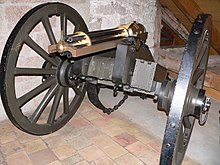
Custer's decision to reject Terry's offer of the rapid-fire Gatlings has raised questions among historians as to why he refused them and what advantage their availability might have conferred on his forces at the Battle of the Little Bighorn. [138][139][140]
One factor concerned Major Marcus Reno's recent 8-day reconnaissance-in-force of the Powder-Tongue-Rosebud Rivers, June 10 to 18.[141][142] This deployment had demonstrated that artillery pieces mounted on gun carriages and hauled by horses no longer fit for cavalry mounts (so-called condemned horses) were cumbersome over mixed terrain and vulnerable to breakdowns.[143][144][145][146] Custer, valuing the mobility of the 7th Cavalry and recognizing Terry's acknowledgement of the regiment as "the primary strike force" preferred to remain unencumbered by the Gatling guns.[147][148][149][150] Custer insisted that the artillery was superfluous to his success, in that the 7th Cavalry alone was sufficient to cope with any force they should encounter, informing Terry: "The 7th can handle anything it meets".[151][152][153][154] In addition to these practical concerns, a strained relationship with Major James Brisbin induced Custer's polite refusal to integrate Brisbin's Second Cavalry unit – and the Gatling guns – into his strike force, as it would disrupt any hierarchical arrangements that Custer presided over.[155][156][157]
Historians have acknowledged the firepower inherent in the Gatling gun: they were capable of firing 350 .45-70 caliber rounds per minute. Jamming caused by black powder residue could lower that rate,[158][159] raising questions as to their reliability under combat conditions.[160][161] Researchers have further questioned the effectiveness of the guns under the tactics that Custer was likely to face with the Lakota and Cheyenne warriors. The Gatlings, mounted high on carriages, required the battery crew to stand upright during its operation, making them easy targets for Lakota and Cheyenne sharpshooters.[162]
Historian Robert M. Utley, in a section entitled "Would Gatling Guns Have Saved Custer?" presents two judgments from Custer's contemporaries: General Henry J. Hunt, expert in the tactical use of artillery in Civil War, stated that Gatlings "would probably have saved the command", whereas General Nelson A. Miles, participant in the Great Sioux War declared "[Gatlings] were useless for Indian fighting." [163]
Weapons[edit]
Lakota and Cheyenne[edit]

The Lakota and Cheyenne warriors that opposed Custer's forces possessed a wide array of weaponry, from war clubs and lances to the most advanced firearms of the day.[164] The typical firearms carried by the Lakota and Cheyenne combatants were muzzleloaders, more often a cap-lock smoothbore, the so-called Indian trade musket or Leman guns[165][166] distributed to Indians by the US government at treaty conventions.[167] Less common were surplus .58 caliber rifled muskets of American Civil War vintage such as the Enfield and Springfield.[168] Metal cartridge weapons were prized by native combatants, such as the Henry and the Spencer lever-action rifles, as well as Sharps breechloaders.[169] Bows and arrows were utilized by younger braves in lieu of the more potent firearms; effective up to 30 yards (27 meters), the arrows could readily maim or disable an opponent.[170]
Sitting Bull's forces had no assured means to supply themselves with firearms and ammunition.[171] Nonetheless, they could usually procure these through post-traders, licensed or unlicensed, and from gunrunners who operated in the Dakota Territory: "...a horse or a mule for a repeater...buffalo hides for ammunition."[172] Custer's highly regarded guide, "Lonesome" Charley Reynolds, informed his superior in early 1876 that Sitting Bull's forces were amassing weapons, including numerous Winchester repeating rifles and abundant ammunition.[173]
Of the guns owned by Lakota and Cheyenne fighters at the Little Bighorn, approximately 200 were repeating rifles[174] corresponding to about 1 of 10 of the encampment's two thousand able-bodied fighters who participated in the battle[175]
7th Cavalry[edit]
The troops under Custer's command carried two regulation firearms authorized and issued by the U.S. Army in early 1876: the breech-loading, single-shot Springfield Model 1873 carbine, and the 1873 Colt single-action revolver.[176] The regulation M1860 saber or "long knives" were not carried by troopers upon Custer's order.[177][178]
With the exception of a number of officers and scouts who opted for personally owned and more expensive rifles and handguns, the 7th Cavalry was uniformly armed.[179][180][181]
Ammunition allotments provided 100 carbine rounds per trooper, carried on a cartridge belt and in saddlebags on their mounts. An additional 50 carbine rounds per man were reserved on the pack train that accompanied the regiment to the battlefield. Each trooper had 24 rounds for his Colt handgun.[182]
The opposing forces, though not equally matched in the number and type of arms, were comparably outfitted, and neither side held a overwhelming advantage in weaponry.[183]
Lever-action repeaters vs. single-shot breechloaders[edit]
Two hundred or more Lakota and Cheyenne combatants are known to have been armed with Henry, Winchester, or similar lever-action repeating rifles at the battle.[174][184] Virtually every trooper in the 7th Cavalry fought with the single-shot, breech-loading Springfield carbine and the Colt revolver.[185]
Historians have asked whether the repeating rifles conferred a distinct advantage on Sitting Bull's villagers that contributed to their victory over Custer's carbine-armed soldiers.[186]
Historian Michael L. Lawson offers a scenario based on archaeological collections at the "Henryville" site, which yielded plentiful Henry rifle cartridge casings from approximately 20 individual guns. Lawson speculates that, though less powerful than the Springfield carbines, the Henry repeaters provided a barrage of fire at a critical point, driving Lieutenant James Calhoun's L Company from Calhoun Hill and Finley Ridge, forcing them to flee in disarray back to Captain Myles Keogh's I Company, and leading to the disintegration of that wing of Custer's Battalion.[187]
Model 1873 Springfield carbine and the U.S. Army[edit]
After exhaustive testing – including comparisons to domestic and foreign single-shot and repeating rifles – the Army Ordnance Board (whose members included officers Marcus Reno and Alfred Terry) authorized the Springfield as the official firearm for the United States Army.[188][189]
The Springfield, manufactured in a .45-70 long rifle version for the infantry and a .45-55 light carbine version for the cavalry, was judged a solid firearm that met the long-term and geostrategic requirements of the United States fighting forces.[190]

British historian Mark Gallear maintains that US government experts rejected the lever-action repeater designs, deeming them ineffective in the event of a clash with fully equipped European armies, or in case of an outbreak of another American civil conflict. Gallear's analysis minimizes the allegation that rapid depletion of ammunition in lever-action models influenced the decision in favor of the single-shot Springfield. The Indian War, in this context, appears as a minor theatre of conflict, whose contingencies were unlikely to govern the selection of standard weaponry for an emerging industrialized nation.[191]
The Springfield carbine is praised for its "superior range and stopping power" by historian James Donovan, and author Charles M. Robinson reports that the rifle could be "loaded and fired much more rapidly than its muzzle loading predecessors, and had twice the range of repeating rifles such as the Winchester, Henry and Spencer."[192][193][194]
Gallear points out that lever-action rifles, after a burst of rapid discharge, still required a reloading interlude that lowered their overall rate of fire; Springfield breechloaders "in the long run, had a higher rate of fire, which was sustainable throughout a battle."[195]
The breechloader design patent for the Springfield's Erskine S. Allin trapdoor system was owned by the US government and the firearm could be easily adapted for production with existing machinery at the Springfield Armory in Massachusetts.[196] At time when funding for the post-war Army had been slashed, the prospect for economical production influenced the Ordnance Board member selection of the Springfield option.[197]
Malfunction of the Springfield carbine extractor mechanism[edit]
The question as to whether the reported malfunction of the Model 1873 Springfield carbine issued to the 7th Cavalry contributed to their defeat has been debated for years.[198]
That the weapon experienced jamming of the extractor is not contested, but its contribution to Custer's defeat is considered negligible. This conclusion is supported by evidence from archaeological studies performed at the battlefield, where the recovery of Springfield cartridge casing, bearing tell-tale scratch marks indicating manual extraction, were rare. The flaw in the ejector mechanism was known to the Army Ordnance Board at the time of the selection of the Model 1873 rifle and carbine, and was not considered a significant shortcoming in the overall worthiness of the shoulder arm.[199] With the ejector failure in US Army tests as low as 1:300, the Springfield carbine was vastly more reliable than the muzzle-loading Springfields used in the Civil War.[200][201]
Gallear addresses the post-battle testimony concerning the copper .45-55 cartridges supplied to the troops in which an officer is said to have cleared the chambers of spent cartridges for a number of Springfield carbines.[202] This testimony of widespread fusing of the casings offered to the Chief of Ordnance at the Reno Court of Inquiry in 1879 conflicts with the archaeological evidence collected at the battlefield. Field data showed that possible extractor failures occurred at a rate of approximately 1:30 firings at the Custer Battlefield and at a rate of 1:37 at the Reno-Benteen Battlefield.[203][204][205]
Historian Thom Hatch observes that the Model 1873 Springfield, despite the known ejector flaw, remained the standard issue shoulder arm for US troops until the early 1890s.[206] when the copper-cased, inside-primed cartridges were replaced with brass.
Survivor claims[edit]
Soldiers under Custer's direct command were annihilated on the first day of the battle (except for three Crow scouts and several troopers (including John Martin (Giovanni Martino)) that had left that column before the battle; one Crow scout, Curly, was the only survivor to leave after the battle had begun), although for years rumors persisted of other survivors.[note 10]
Over 120 men and women would come forward over the course of the next 70 years claiming they were "the lone survivor" of Custer's Last Stand.[207] The phenomenon became so widespread that one historian remarked, "Had Custer had all of those who claimed to be 'the lone survivor' of his two battalions he would have had at least a brigade behind him when he crossed the Wolf Mountains and rode to the attack."[208]
The historian Earl Alonzo Brininstool suggested he had collected at least 70 "lone survivor" stories.[209][210] Michael Nunnally, an amateur Custer historian, wrote a booklet describing 30 such accounts.[211] W. A. Graham claimed that even Libby Custer received dozens of letters from men, in shocking detail, about their sole survivor experience.[212] At least 125 alleged "single survivor" tales have been confirmed in the historical record as of July 2012.
Frank Finkel, from Dayton, Washington, had such a convincing story that historian Charles Kuhlman[213] believed the alleged survivor, going so far as to write a lengthy defense of Finkel's participation in the battle.[214] Douglas Ellison—mayor of Medora, North Dakota, and an amateur historian—also wrote a book in support of the veracity of Finkel's claim,[215] but most scholars reject it.[216][217]
Some of these survivors held a form of celebrity status in the United States, among them Raymond Hatfield "Arizona Bill" Gardner[218] and Frank Tarbeaux.[219] A few even published their own autobiographies, including their deeds at the Little Bighorn.[220][221][222]
Almost as soon as men came forward implying or directly pronouncing their unique role in the battle, there were others who were equally opposed to any such claims. Theodore Goldin, a battle participant who later became a controversial historian on the event, wrote (in regards to Charles Hayward's claim to have been with Custer and taken prisoner):
The Indians always insisted that they took no prisoners. If they did—a thing I firmly believe—they were tortured and killed the night of the 25th. As an evidence of this I recall the three charred and burned heads we picked up in the village near the scene of the big war dance, when we visited the village with Capt. Benteen and Lieut. Wallace on the morning of the 27th... I'm sorely afraid, Tony, that we will have to class Hayward's story, like that of so many others, as pure, unadulterated B. S. As a clerk at headquarters I had occasion to look over the morning reports of at least the six troops at Lincoln almost daily, and never saw his name there, or among the list of scouts employed from time to time ... I am hoping that some day all of these damned fakirs will die and it will be safe for actual participants in the battle to admit and insist that they were there, without being branded and looked upon as a lot of damned liars. Actually, there have been times when I have been tempted to deny that I ever heard of the 7th Cavalry, much less participated with it in that engagement ... My Medal of Honor and its inscription have served me as proof positive that I was at least in the vicinity at the time in question, otherwise I should be tempted to deny all knowledge of the event.[223]
The only documented and verified survivor of Custer's command (having been actually involved in Custer's part of the battle) was Captain Keogh's horse, Comanche. The wounded horse was discovered on the battlefield by General Terry's troops, and although other cavalry mounts survived they had been taken by the Indians. Comanche eventually was returned to the fort and became the regimental mascot.[note 11] Several other badly wounded horses were found and killed at the scene.[224] Writer Evan S. Connell noted in Son of the Morning Star:[225]

Comanche was reputed to be the only survivor of the Little Bighorn, but quite a few Seventh Cavalry mounts survived, probably more than one hundred, and there was even a yellow bulldog. Comanche lived on another fifteen years, and when he died, he was stuffed and to this day remains in a glass case at the University of Kansas. So, protected from moths and souvenir hunters by his humidity-controlled glass case, Comanche stands patiently, enduring generation after generation of undergraduate jokes. The other horses are gone, and the mysterious yellow bulldog is gone, which means that in a sense the legend is true. Comanche alone survived.
Battlefield preservation[edit]


The site of the battle was first preserved as a United States national cemetery in 1879 to protect the graves of the 7th Cavalry troopers. In 1946, it was re-designated as the Custer Battlefield National Monument, reflecting its association with Custer. In 1967, Major Marcus Reno was re-interred in the cemetery with honors, including an eleven-gun salute. Beginning in the early 1970s, there was concern within the National Park Service over the name Custer Battlefield National Monument failing to adequately reflect the larger history of the battle between two cultures. Hearings on the name change were held in Billings on June 10, 1991, and during the following months Congress renamed the site the Little Bighorn Battlefield National Monument.
United States memorialization of the battlefield began in 1879 with a temporary monument to the U.S. dead. In 1881, the current marble obelisk was erected in their honor. In 1890, marble blocks were added to mark the places where the U.S. cavalry soldiers fell.
Nearly 100 years later, ideas about the meaning of the battle have become more inclusive. The United States government acknowledged that Native American sacrifices also deserved recognition at the site. The 1991 bill changing the name of the national monument also authorized an Indian Memorial to be built near Last Stand Hill in honor of Lakota and Cheyenne warriors. The commissioned work by native artist Colleen Cutschall is shown in the photograph at right. On Memorial Day 1999, in consultation with tribal representatives, the U.S. added two red granite markers to the battlefield to note where Native American warriors fell. As of December 2006, a total of ten warrior markers have been added (three at the Reno–Benteen Defense Site and seven on the Little Bighorn Battlefield).[229]
The Indian Memorial, themed "Peace Through Unity" l is an open circular structure that stands 75 yards (69 metres) from the 7th Cavalry obelisk. Its walls have some of the names of Indians who died at the site, as well as native accounts of the battle. The open circle of the structure is symbolic, as for many tribes, the circle is sacred. The "spirit gate" window facing the Cavalry monument is symbolic as well, welcoming the dead cavalrymen into the memorial.[230]

